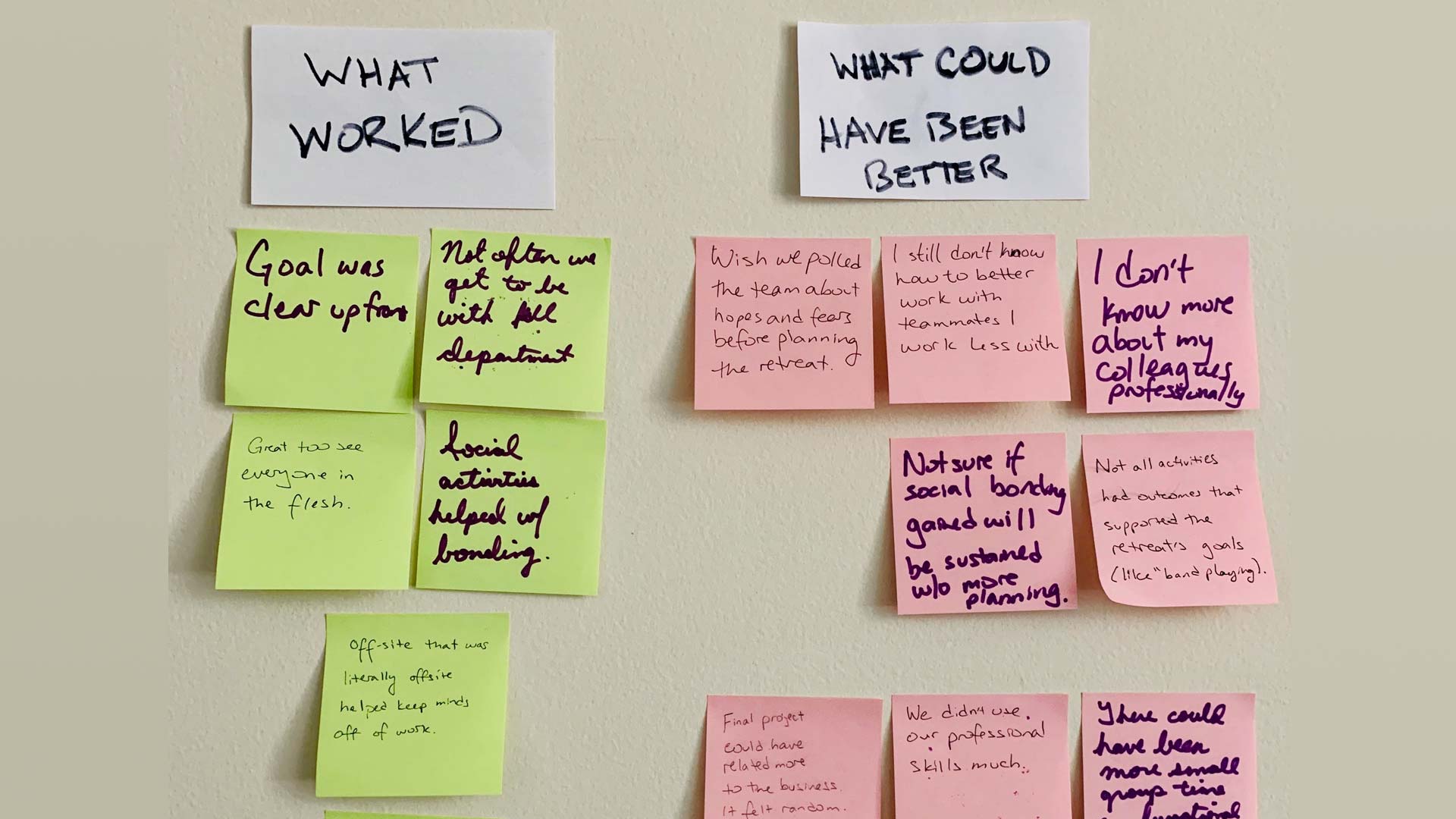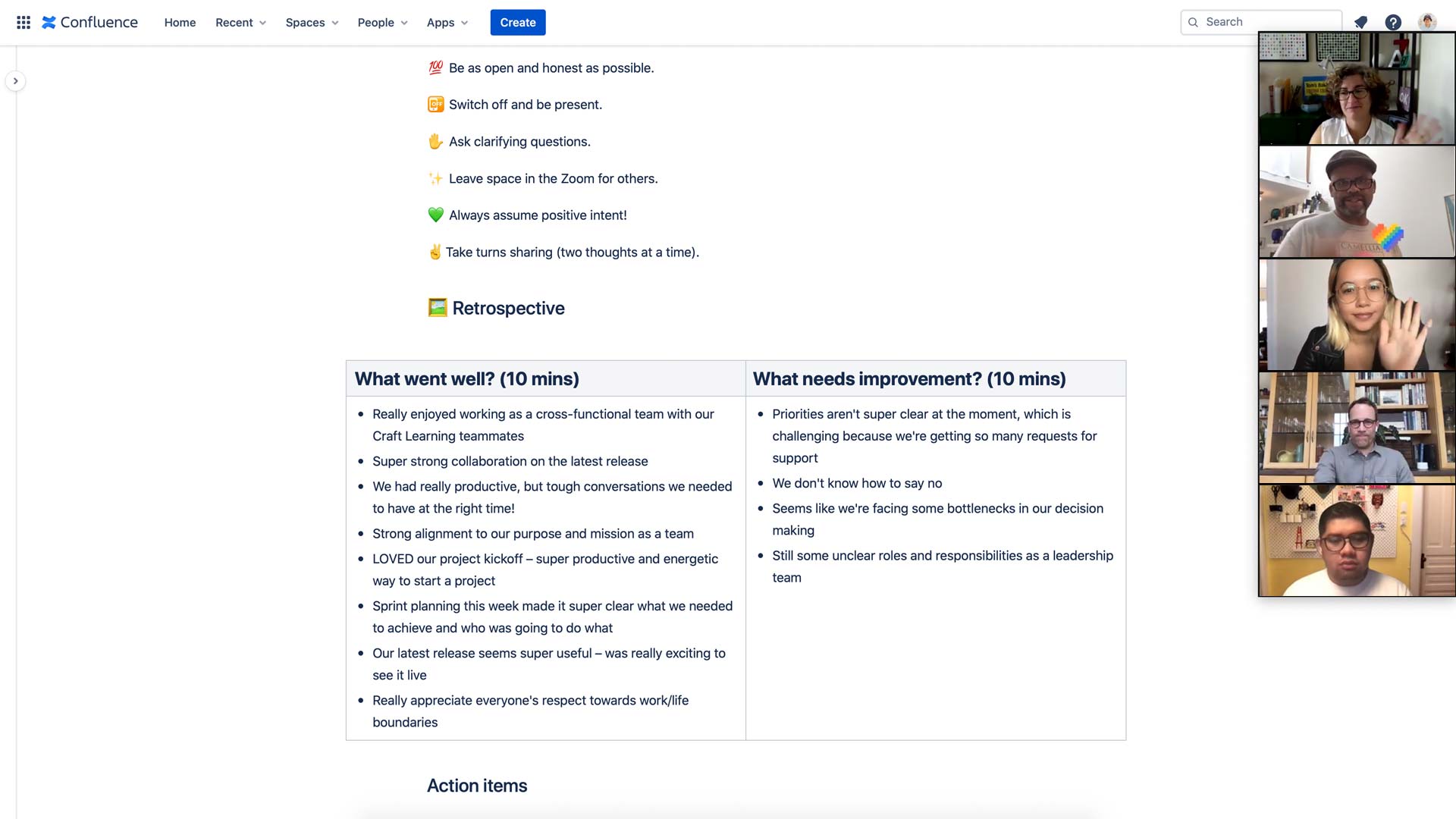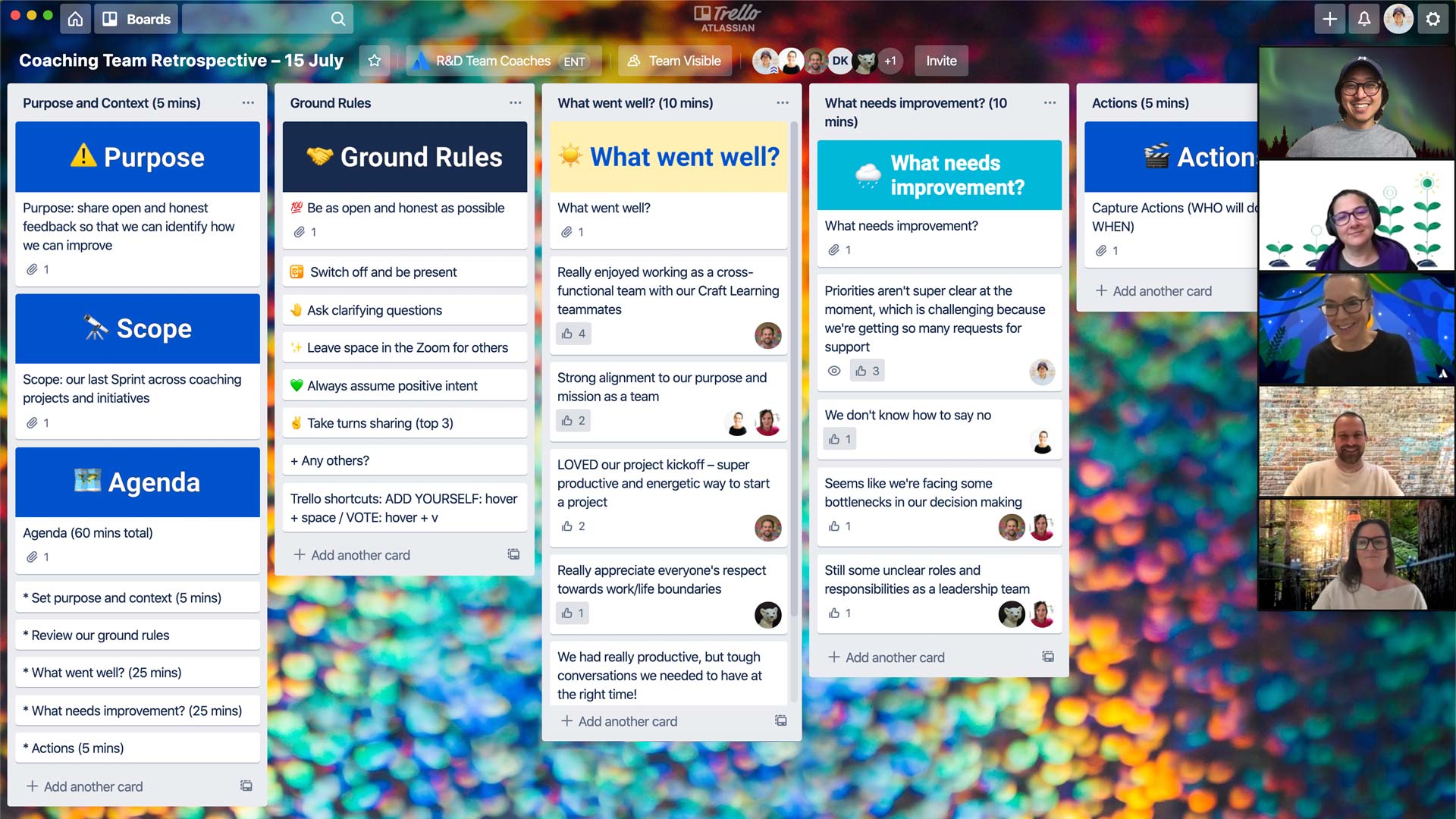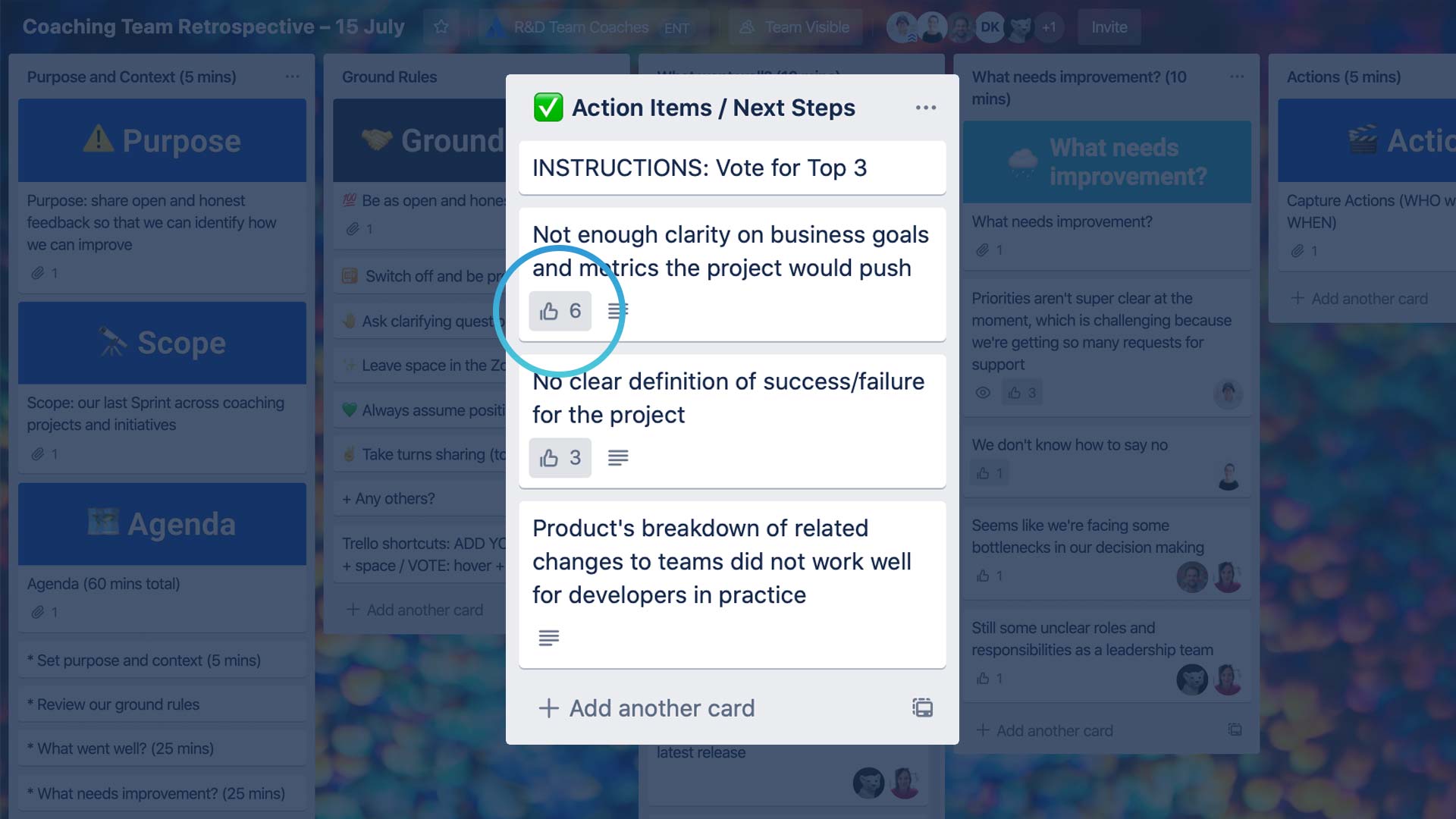¿Qué es la Retrospectiva de Sprint?
La Retrospectiva de Sprint es una revisión que se realiza después de un sprint y que desempeña un papel clave en la metodología ágil. El objetivo de la Retrospectiva de Sprint es determinar qué ha ido bien y dónde ha habido problemas, e identificar las áreas en las que puedes mejorar.
Las revisiones periódicas son una parte esencial de la colaboración en equipo. Sabiendo qué funciona y qué no, puedes mejorar los procesos ágiles para simplificar tu próximo sprint.
¿Quién debe asistir a una reunión de Retrospectiva de Sprint?
La reunión de Retrospectiva de Sprint debe incluir al propietario del producto, al equipo de scrum, al experto en scrum y a las partes interesadas. En una reunión de Retrospectiva de Sprint, es bueno contar con distintos puntos de vista en la sala. Todos pueden colaborar para analizar tu último sprint y determinar qué cambios debes realizar antes de iniciar la siguiente parte del proyecto.
¿Por qué importan las Retrospectivas de Sprint?
Realizar una Retrospectiva de Sprint te permite aprender de tus esfuerzos anteriores y mejorar los futuros sprints, consiguiendo sprints de scrum optimizados y un mejor resultado final. Estas son algunas de las ventajas de utilizar la Retrospectiva de Sprint:
- Fomenta la mejora continua
- Mejora la colaboración en equipo
- Promueve la resolución de problemas
- Evita que se repitan los errores
- Ofrece mejores resultados de calidad
- Mejora la moral del equipo
Las retrospectivas en acción
Notas rápidas de un equipo en las que se recogen las ideas surgidas en una retrospectiva llevada a cabo fuera de las instalaciones.
Este equipo utiliza Confluence para resumir la conversación que han mantenido durante su retrospectiva.
Esta retrospectiva se ha llevado a cabo mediante Zoom, con la ayuda de Trello para establecer reglas básicas, añadir ideas y orientar la discusión.
Material necesario
A distancia
Videoconferencia con función de compartir pantalla
Herramienta de colaboración digital (consulta las plantillas)
Presencial
Lugar para mantener la reunión
Pizarra u hoja grande de papel
Rotuladores
Notas adhesivas
Cronómetro
Plantillas recomendadas
Plantillas de Atlassian
5 pasos para realizar una reunión de Retrospectiva de Sprint con éxito
Además de utilizar plantillas retrospectivas, puedes seguir unos sencillos pasos para realizar una reunión de Retrospectiva de Sprint con éxito. Se debe animar a todos los miembros del equipo para que contribuyan a la reunión. Una vez que hayas recopilado el feedback, puedes analizarlo y crear elementos de acción para mejorar.
Estos son los 5 pasos para realizar una reunión de Retrospectiva de Sprint con éxito:
Paso 1. Establece el contexto
Para hacer una retrospectiva de un sprint, el primer paso es crear un ambiente adecuado. El objetivo de planificar sprints es reunir comentarios desde distintos puntos de vista y utilizarlos para definir objetivos y mejorar los procesos ágiles. Todo el mundo debe sentir que puede opinar en la revisión de un sprint, por lo que debes crear esa atmósfera desde el principio de la reunión.
Te interesa animar a que la gente comente y ofrezca datos relevantes y valiosos durante la retrospectiva del sprint. Céntrate en mejorar, no en culpar a nadie de ningún error, y deja que todos se comuniquen de forma abierta y sincera.
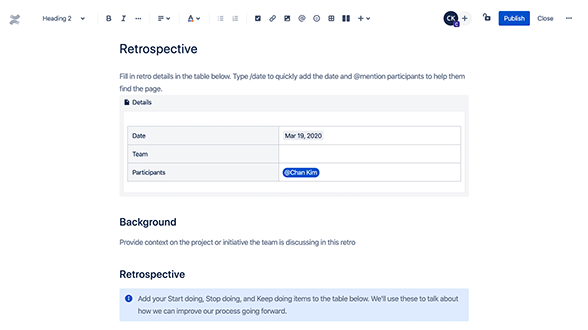
Ejemplo: Confluence
¿Vas a llevar a cabo esta estrategia a distancia? Utiliza esta plantilla de retrospectiva gratuita para orientar el debate y plasmar los resultados de la sesión.
Paso 2. Recopila comentarios
En cuanto hayas creado la atmósfera adecuada y todo el mundo sepa qué es lo que quieres que aporten, estarás en situación de recopilar comentarios de los miembros del equipo. La retrospectiva de las 4 "L" es una forma de recopilar comentarios que consiste en preguntarle a todo el mundo qué es lo que les ha encantado y lo que han odiado, aprendido y anhelado (loved, loathed, learned y longed for, respectivamente, en inglés) durante un sprint. Si a la gente le cuesta dar comentarios detallados, usar las 4 "L" sirve de guía básica.
Existen varias formas de recopilar comentarios de todo el mundo en la retrospectiva de un sprint. Si a todo el mundo le parece bien, podéis hacer un debate en grupo. También puedes pedirles a los miembros del equipo que rellenen encuestas o envíen comentarios anónimos que puedas utilizar para mejorar el próximo sprint.
Consejo: personaliza esta lista
Modifica las reglas para que se adapten a las necesidades específicas de tu equipo. Añade todo lo que creas que pueda contribuir a que el equipo mejore.
Consejo: crea un espacio seguro
Define la forma en la que se debatirá la información tras la realización de la estrategia y si se compartirá con el equipo de liderazgo. Plantéate la adopción de la Regla de Chatham House.
Paso 3. Genera datos relevantes
Recopilar comentarios es solo una parte de la lucha que supone hacer una retrospectiva de un sprint: también tienes que actuar en consecuencia. Analiza los comentarios que has recibido para buscar patrones y tendencias que puedan ayudarte a conocer mejor a tu equipo y el sprint anterior.
Estos datos relevantes son un componente clave para la fijación de objetivos, así que anima a todo el mundo a que colabore y aporte toda información valiosa que pueda tener. Ya hemos mencionado lo importante que es tener diversos puntos de vista en una reunión de revisión de sprint, y esto es algo que queda patente a la hora de generar datos relevantes.
Paso 4. Crear elementos de acción
Cuando hayas obtenido más información sobre tu equipo agile y el último sprint, podrás convertir esos datos relevantes en elementos procesables. Es en este momento cuando puedes empezar a marcar objetivos y determinar qué cambios hacer para sprints futuros.
Es esencial establecer objetivos SMART: eSpecíficos, Mensurables, fActibles, peRtinentes y Temporales. Fijar objetivos SMART es crucial para el éxito, garantiza que tus objetivos sean alcanzables y aporta resultados pertinentes para tu empresa.
Consejo: asegúrate de que se escuchen todas las opiniones
Si una o dos personas acaparan el debate, el instructor debe intervenir y preguntar a otras personas antes de pasar al siguiente tema.
Paso 5. Concluye la retrospectiva
Ahora que has tomado medidas para aprender del último sprint y mejorar el siguiente, puedes dar por concluida la reunión de retrospectiva de sprint. Ofrece un resumen de las conclusiones principales de la reunión, dales las gracias a todas las personas que hayan aportado algo a la reunión y transmíteles a todos una sensación de cierre.
Al terminar la reunión de retrospectiva de sprint, deberías tener un plan de implementación claro para que no se desperdicie el duro trabajo que habéis hecho. Saber cómo implementar los cambios es un componente clave de las reuniones sobre sprints.
Consejo: actualiza tus flujos de trabajo
Si alguna de las medidas tiene incidencias de Jira asociadas, incluye un enlace a ellas en la página para que se pueda consultar su estado fácilmente.
Incluye las medidas planteadas en la retrospectiva en tu día a día, ya sea en las reuniones rápidas o en las actualizaciones de estado semanales del equipo.
Ideas para reuniones de retrospectiva de sprint
Como líder de un equipo agile, tu trabajo va más allá de entender los aspectos básicos del tablero de scrum: tienes que dirigir las reuniones para generar datos relevantes y valiosos. Examinar ejemplos de retrospectivas de sprints puede ayudarte a desarrollar ideas para la próxima reunión de retrospectiva de sprint, de forma que puedas optimizar el proceso y recopilar comentarios valiosos.
Usar el método de las 4 "L" puede animar a los miembros del equipo a comentar y, de este modo, puedas hacerte rápidamente una idea de lo que salió bien y de lo que tienes que mejorar.
También puedes utilizar el marco de trabajo "triste, enfadado y contento" para suscitar un debate en la próxima retrospectiva de sprint. Basta con crear tres columnas que le sirvan a tu equipo de plantilla para aportar sus comentarios:
- Triste: ¿Qué es lo que te decepcionó? ¿Hubo algún aspecto que consideraras que podrías mejorar?
- Enfadado: ¿Qué te frustró? ¿Hubo algo que te impidiera dar lo mejor de ti?
Contento: ¿Cuáles fueron los momentos del proyecto que te gustaron más? ¿Qué crees que salió bien?
Existen varias formas de fomentar el debate en las retrospectivas de sprint, así que no dudes en experimentar para mantener el dinamismo de las reuniones. Ten en cuenta que algunos equipos podrían preferir que sus comentarios fueran anónimos, y eso no tiene nada de malo. Puedes adaptar las retrospectivas de los sprint hasta que determines qué es lo que funciona con tu equipo.
Ideas para reuniones de retrospectiva de sprint
Las retrospectivas de sprints pueden antojarse abrumadoras al principio, pero son un concepto bastante sencillo. Puedes usar una plantilla de retrospectiva de sprint o seguir los cinco pasos indicados en esta guía. Mientras recopiles comentarios y los utilices para generar datos relevantes y aplicar cambios, lo estarás haciendo bien.
Toda retrospectiva de sprint comienza con un sprint terminado con éxito. Jira ofrece varias funciones clave que pueden ayudarte a organizar sprints que salgan bien, entre las que se incluyen las siguientes:
- Backlog: los backlogs te permiten hacer una lista de todo el trabajo relacionado con un proyecto o una iniciativa. Puedes dividir este trabajo en sprints individuales, que suelen durar dos semanas.
- Tableros: los tableros de Jira te permiten dividir un proyecto grande en partes más manejables para que puedas planificar tus sprints y, de este modo, agilizar tus entregas.
- Cronogramas: los cronogramas mantienen a tu equipo en sincronía con las partes interesadas y proporcionan una visión de conjunto del cronograma del proyecto con los elementos de trabajo, dependencias y publicaciones asignados.
Jira facilita a los equipos agile la visualización, el seguimiento y la gestión de los sprints. Con Jira, puedes optimizar tu próximo sprint para asegurarte de que todo se entregue a tiempo. Prueba los tableros de scrum de Jira y descubre cómo puede ayudarte Jira a optimizar tu equipo agile.
Retrospectiva de sprint: preguntas frecuentes
¿Cuáles son algunos de los desafíos más habituales al hacer una retrospectiva de un sprint?
La falta de comentarios es uno de los mayores desafíos a los que te puedes enfrentar en la retrospectiva de un sprint. Si las personas no son transparentes o les da reparo para dar comentarios detallados, cuesta determinar qué salió bien y qué no. Puedes propiciar una mejora en las aportaciones si planteas una estructura sencilla para la retrospectiva del sprint, por ejemplo, el método "triste, enfadado, contento" y el de las 4 "L". También puedes probar a recopilar comentarios de forma anónima.
Asimismo, debes evitar centrarte en errores o logros puntuales. El objetivo de las retrospectivas de sprints es mejorar el próximo sprint, así que no te centres en los comentarios que no afecten al resto del proyecto.
¿Cuánto tiempo debe durar una reunión de retrospectiva de sprint?
La duración de la reunión de retrospectiva de sprint puede variar según lo que durara el sprint. Las retrospectivas de sprints pueden durar tan solo 45 minutos o hasta 3 horas, todo depende del sprint. Aunque quieras hacerlo todo con eficiencia, durante una retrospectiva de sprint es importante darle a tu equipo el tiempo suficiente para que se genere un debate productivo y se puedan hacer avances.
¿Qué preguntas conviene plantear en una retrospectiva de sprint?
Hay varias formas de suscitar el debate en una retrospectiva de sprint. Puedes utilizar el método de las 4 "L" para preguntarle a la gente qué fue lo que les encantó, lo que odiaron, lo que aprendieron y lo que anhelaron en el sprint. También puedes utilizar el método "triste, enfadado y contento" para profundizar en el último sprint. Estas son algunas de las preguntas que podría interesarte plantear durante una retrospectiva de sprint:
- ¿Qué ha salido bien?
- ¿Qué estuvo mal?
- ¿Qué aprendiste?
¿Qué cambios podemos hacer?
Explora otras estrategias
De nuestro equipo para el tuyo
Mantente al tanto de los últimos consejos, trucos y estrategias con nuestro boletín mensual.

